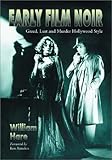1 CommentReply |
MenuLatest GadetsRecent Reviews
Archives
|
Notcot
Gizmos, Gadgets, Noir and Steampunk
1 CommentReply |
|
Copyright © 2024 Notcot All rights reserved. Theme by Laptop Geek. Site by I Want This Website. | Privacy Policy.

Do you like your movies filled with suspense and evil? Did you enjoy any of the following movies: The Maltese Falcon; Double Indemnity; Murder, My Sweet; Crossfire; Out of the Past; Laura; The Postman Always Rings Twice; The Third Man; or Across the Bridge? If you answered “yes” to either question, I highly recommend Early Film Noir to you.
Mr. Hare has written a fine exposition of how the film noir style evolved, the development of the key films in this genre and brief biographies of the important actors, directors, cameramen and producers who influenced the key films. If you are unfamiliar with any of the films, Mr. Hare does an excellent job of summarizing the story lines so that you can understand the subject without having seen the films. I have seen all of these films many times, and encourage you to use the book to decide which ones you would enjoy.
If you already have a great knowledge in this area, you may find the book to be mostly redundant to what you know already. As someone who had seen the films but not studied their backgrounds, this book added greatly to my understanding of the films and my appreciation of them. I especially enjoyed learning about how the scripts were developed. Some books translate easily onto the big screen, while others require substantial story and dialogue development. The Third Man is especially interesting from this perspective.
Each chapter includes one or more great stills from the films. Those add just the right touch of adding noir color.
Many books about film focus on the most famous people involved. Mr. Hare has made a great decision to focus instead on those who are most intriguing. I had always found Jane Greer to be fascinating on screen and was pleased to find a while chapter about her.
Before reading this book, I did not fully realize the connection between the detective novels of Dashiell Hammett and Raymond Chandler and the later developments of film noir and Albert Camus’s writing. Making that link was a very helpful perspective for me.
As I finished the book, I realized that one of the appeals for me about film noir is that the female characters have strength, texture and nuance . . . just like real women. Early film noir was way ahead of its time in portraying the image of women as having all of the potential to be saints and devils that men have. I wondered about why so many current films seem to present women as having more potential than men. Does that mean we will come to see that as the reality in the future?
Rating: 5 / 5